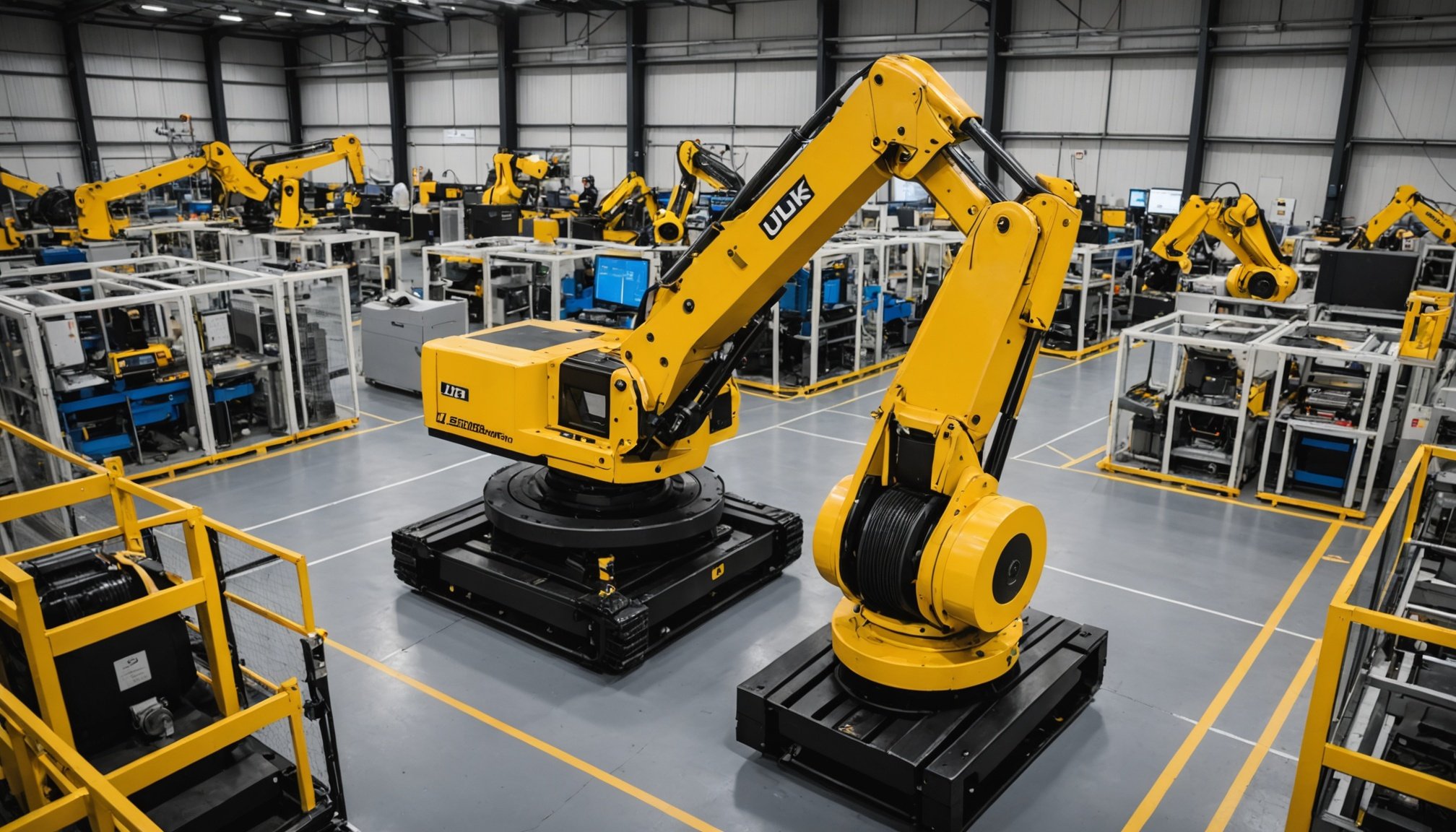Transforming UK Manufacturing: Harnessing IoT Innovations for Superior Operational Efficiency
The manufacturing sector in the UK is on the cusp of a revolutionary transformation, driven by the integration of Internet of Things (IoT) innovations. These cutting-edge technologies are not just enhancing operational efficiency but are also redefining the way manufacturers produce, manage, and deliver products. Here’s a deep dive into how IoT is transforming the manufacturing landscape.
The Power of IoT in Manufacturing
IoT is more than just a buzzword; it is a game-changer for the manufacturing industry. By connecting devices, machines, and systems, IoT enables real-time data collection and analysis, which is crucial for making informed decisions.
Additional reading : Top tips for selecting the ideal building supplier for your project
Real-Time Data and Decision Making
One of the key advantages of IoT in manufacturing is its ability to provide real-time data. This data, when combined with machine learning (ML) and artificial intelligence (AI), allows for rapid decision-making. For instance, IoT sensors attached to machines on the factory floor can monitor performance in real time, alerting operators to potential issues before they become major problems. This predictive maintenance approach not only reduces downtime but also extends the life of machines[1].
"Edge computing is crucial to managing industrial data, because edge moves the compute into the plant itself, allowing for rapid response where the data is generated," says Anthony Sayers.
Predictive Maintenance and Resource Optimization
Predictive maintenance is a cornerstone of IoT-driven efficiency. By monitoring a machine’s ‘vital signs’ in real time, manufacturers can anticipate and prevent failures. This approach has been shown to cut equipment downtime by 50% and lower maintenance costs by 20%[2].
Topic to read : Development cooperation instrument: boosting global sustainability and stability
Here are some key benefits of predictive maintenance enabled by IoT:
- Reduced Downtime: IoT sensors can shift maintenance from calendar- or milestone-driven to condition- or data-driven, significantly reducing unexpected maintenance costs[4].
- Extended Machine Life: Predictive maintenance ensures that machines are repaired before they fail, extending their operational life.
- Resource Optimization: Real-time insights from IoT sensors help in optimizing resource utilization, minimizing downtimes, and maximizing productivity[4].
Smart Factories and Digital Twins
The concept of smart factories is gaining traction, and IoT is at the heart of this transformation. Smart factories integrate IoT devices, AI, and ML to create a highly efficient and connected manufacturing environment.
Digital Twins: A Virtual Reality
Digital twins are virtual replicas of physical systems that allow manufacturers to simulate and optimize manufacturing processes before real-world application. This innovation reduces costly errors and improves overall efficiency.
"Digital twins allow manufacturers to create digital replicas of physical systems, enabling simulation and optimization of manufacturing processes before real-world application," notes an article from The Engineer[2].
Here are some benefits of digital twins:
- Simulation and Optimization: Digital twins enable teams to analyze different data sources, minimizing faulty units and reducing downtime[4].
- Improved Planning: Implementing digital twin technology can improve planning efficiency by reducing duplication of efforts and the need for manual intervention[4].
- Enhanced Quality Control: Digital twins help in detecting anomalies and preventing defects before they escalate, ensuring products meet exacting standards[2].
Integration and Management of IoT Devices
The integration of IoT devices into manufacturing operations is not just about installing sensors and machines; it requires a comprehensive approach to data management and security.
Data Integration and Analytics
Effective data integration is crucial for harnessing the full potential of IoT. Manufacturers need to bring together data from various sources, including machines, sensors, and suppliers, to create a unified view.
"We have lots of sources of data, lots of machines, lots of suppliers, lots of customers, and bringing that all together from lots of different formats is really critical," says Adam Lucas, Head of Commercial at AVPE Systems[3].
Here are some key aspects of data integration and analytics:
- Unified Data View: Combining data from different sources to create a comprehensive view of operations.
- Real-Time Insights: Using data analytics to provide real-time insights into production processes, identifying anomalies and preventing defects[2].
- Big Data Management: Managing large volumes of data generated by IoT devices to drive productivity improvements[3].
Workforce Management and Safety
IoT is not just about machines; it also plays a significant role in workforce management and safety.
Enhancing Workforce Productivity
IoT technologies such as connected ID badges, proximity sensors, and computer vision can enhance site security, reduce workplace accidents, and improve worker safety.
Here are some ways IoT enhances workforce management:
- Real-Time Monitoring: IoT sensors provide a real-time view of workforce productivity, allowing managers to monitor performance without physically being on the factory floor[5].
- Safety Measures: IoT technologies notify management if workers are in the wrong location, enhancing site security and reducing accidents[4].
Supply Chain Management and Quality Assurance
IoT innovations are also transforming supply chain management and quality assurance processes.
Real-Time Supply Chain Visibility
IoT sensors can provide near real-time customer demand signals, ending the overreliance on demand forecasting and out-of-date historical trends.
Here are some benefits of IoT in supply chain management:
- Demand-Driven Supply Chain: IoT sensors give greater insight into customer demand, enabling a more responsive and efficient supply chain[4].
- Inventory Management: IoT enables real-time inventory monitoring, allowing for automatic re-ordering and refill notifications[5].
Quality Assurance
IoT sensors can detect anomalies in workflows, adjust unwanted fluctuations in environmental conditions, and monitor post-production storage conditions.
Here are some ways IoT improves quality assurance:
- Defect Detection: IoT sensors identify quality control issues in real time, ensuring products meet exacting standards and reducing return rates[2].
- Consistent Quality: AI and ML provide real-time insights into production processes, preventing defects before they escalate[2].
Case Study: Implementing IoT Solutions
To illustrate the practical application of IoT in manufacturing, let’s consider a case study.
Example: AVPE Systems
AVPE Systems, a manufacturing company, implemented IoT solutions to enhance their operations. Here’s how they benefited:
- Increased Output: By using data-driven insights, AVPE Systems increased their output during a period of exponential growth, upscaled their operations, and met customer demand more effectively[3].
- Improved Productivity: The company used machine monitoring technology to identify bottlenecks and causes of downtime, leading to continuous improvements in productivity[3].
Challenges and Solutions in IoT Adoption
While IoT offers numerous benefits, its adoption is not without challenges.
Interoperability of Data
One of the significant challenges is the interoperability of data from different IoT devices and systems.
Here are some solutions to overcome this challenge:
- Standardization: Implementing standardized communication protocols to ensure seamless data exchange between different devices and systems.
- Data Integration Platforms: Using platforms that can integrate data from various sources, providing a unified view of operations[3].
The integration of IoT innovations in UK manufacturing is a transformative journey that promises superior operational efficiency, improved quality, and enhanced productivity. By leveraging IoT, AI, ML, and digital twins, manufacturers can create smart factories that are faster, more efficient, safer, and cheaper to run.
Here is a summary of the key points discussed:
| Aspect | Benefits |
|---|---|
| Predictive Maintenance | Reduces downtime, extends machine life, lowers maintenance costs |
| Digital Twins | Simulates and optimizes manufacturing processes, improves planning efficiency, enhances quality control |
| Data Integration and Analytics | Provides real-time insights, identifies anomalies, prevents defects |
| Workforce Management | Enhances site security, reduces workplace accidents, improves worker safety |
| Supply Chain Management | Provides real-time demand signals, ends overreliance on forecasting |
| Quality Assurance | Detects defects in real time, ensures consistent quality |
As the manufacturing sector continues to evolve, embracing IoT innovations will be crucial for staying competitive and achieving superior operational efficiency.
"A lot of the wins to be had today on a manufacturing shop floor come from manufacturers using data and analytics to empower humans to work better and smarter," says Chris Iveson, CEO of FourJaw Manufacturing Analytics[3].











